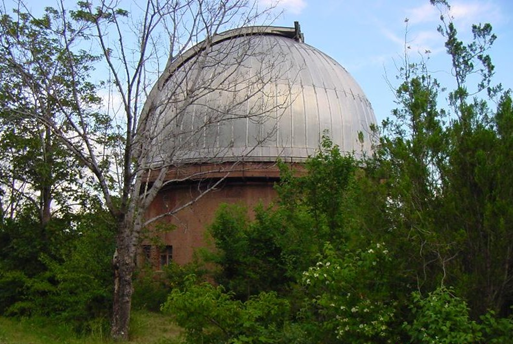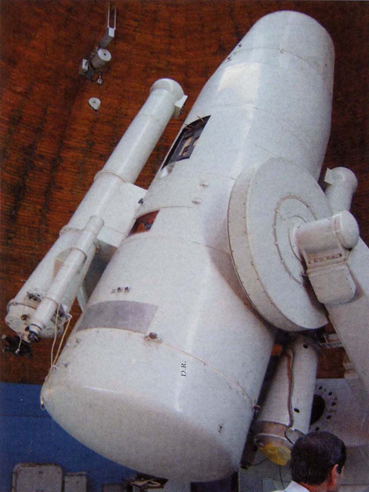1m SCHMIDT TELESCOPE
|
Observing Programs
- Detailed colorimetry of bright galaxies
- First Byurakan Survey (FBS, Markarian survey)
- Search for flare stars in Pleiades
- Search for flare stars in Orion
- Search for flare stars in NGC 7000 (Cygnus)
- Search for flare stars in Praesepe
- Search for flare stars in Taurus Dark Clouds
- Second Byurakan Survey (SBS)
- Extension of the FBS in the Galactic Plane
|
 |
| In operation | since 1960 (first light in 1961) |
| Altitude | 1397 m |
| Constructed by | Leningrad (St. Petersburg) Optical Equipment Works |
| Mounting type | Fork |
| Correcting lense | 102 cm (40²) |
| Mirror | 132 cm (52²) |
| Focal length | 213 cm (84²) |
| Aperture ratio (D/F) | 1:2.1 |
| Field | 4.1°×4.1° |
| Plate size | 16.1×16.1 cm |
| Scale | 96.8 ²/mm |
| Mirror material | Pyrex |
| Optic by | Leningrad (St. Petersburg) Optical Equipment Works |
| Objective prisms (dispersion near Hg) | 1.5° (1800 Å/mm)
3° (900 Å/mm)
4° (285 Å/mm) |
|
 |
The BAO 1m Schmidt telescope is one of the largest Schmidt-type telescopes in the world and one of the most efficient astronomical telescopes in general.
The telescope was installed in 1960 at an altitude of 1397 m in the main territory of the Byurakan Observatory. It was constructed by the Leningrad (St. Petersburg) Optical Equipment Works (LOMO), however the mirror was made in Germany. The mounting type is fork. The telescope’s correcting lens has 102 cm (40²) diameter, and the Pyrex mirror’s diameter is 132 cm (52²). The focal length is 213 cm (84²), and the aperture ratio (D/F) is 1:2.1. The telescope has 4.1°´4.1° non-vignette field. 16.1´16.1 cm size photographic plates have been used. The scale is 96.8 ²/mm. Due to a Piazzi-Smith lens the telescope has a flat field. The optics is made of uviol glass and the optical system is corrected for the blue spectral range.
One of the 1m Schmidt telescope’s advantages was the presence of its three objective prisms (1.5°, 3°, and 4°), which made possible wide-field spectroscopic observations with various dispersions: 1800 Å/mm, 900 Å/mm, 285 Å/mm dispersion near Hg for 1.5°, 3°, and 4° prisms, respectively. The objective prisms can rotate in the position angle that allows obtaining spectra of any orientation.
The First Byurakan Survey (FBS) is the most famous work done with this telescope. More than 2000 photographic plates were obtained. 1500 objects were selected, which are known at present as Markarian galaxies. The continuation of the FBS is Second Byurakan Survey (SBS) carried out with 1m Schmidt telescope. Total number of the discovered peculiar objects is about 3000, about 1600 of which are stellar and 1400 are non-stellar objects. The SBS is one of the most effective surveys in respect of discovery of bright QSOs. Extensive work on discovery and investigation of flare stars in open stellar clusters and associations has been also carried out with the help of 1m Schmidt telescope. Since 1969 more than 500 flare stars have been discovered. Detailed colorimetry of bright galaxies has been carried out on this telescope as well.
In 1991, the 1m Schmidt telescope was stopped and since then no observations have been carried out. Recently, a project for reconstruction of this telescope was put forward in collaboration with the Russian Special Astrophysical Observatory (SAO), including equipping it with a contemporary detector and advanced controlling system. Photometry in wide-band filters and slitless spectroscopy with objective prisms will be the main observing modes. The re-equipment of 1m telescopes must include the installation of a CCD camera in the focus with pixel size of about 1 arcsec and field of view of ~2 deg2; constitution of a set of middle and broad band filters covering all visible range (3400–10000Å); creation of fully-automated control and monitoring system of the telescope including guiding system, control of CCD, feeding of filters to the telescope focus, controlling of the dome, etc. The principal purpose of the re-equipment of the telescopes is the creation of possibility to obtain samples of objects up to R~23m with signal-to-noise ratio of ~5 and images better than 2². Such data ensure the successful classification of objects and measurement of redshifts by analysis of energy distribution in the objects spectra.

